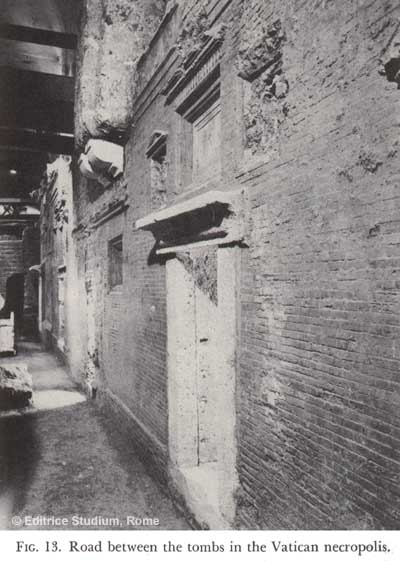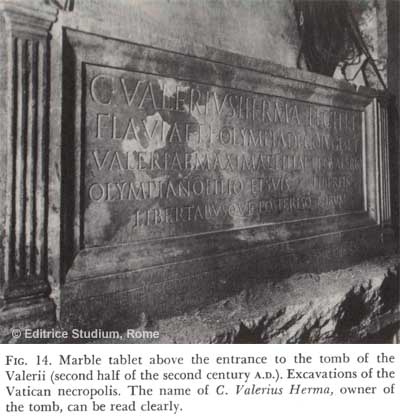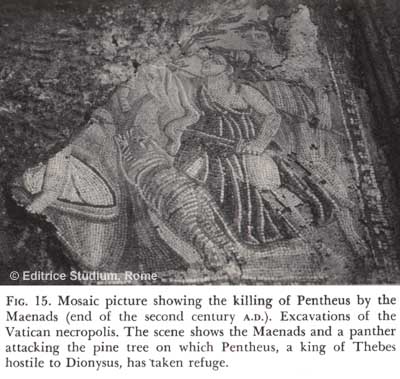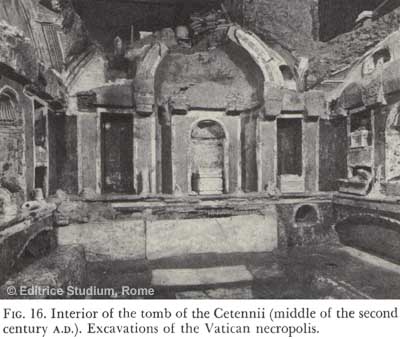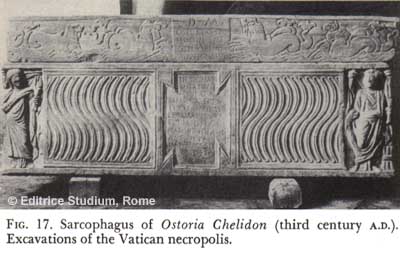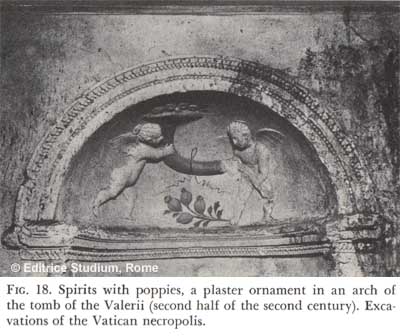by Margherita Guarducci
© 1960, Hawthorn Books
(all rights reserved)
| Grottoes
Vatican City Colonnade Saints Floorplan #2 |
|
|
|
|
CONTENTS
Introduction
- H. V. Morton
Preface - The Author
Illustrations
I. THE TESTIMONY OF ANCIENT AUTHORS
II. THE VATICAN IN ANCIENT TIMES
III. THE NECROPOLIS UNDER
THE BASILICA
IV. THE APOSTLES MEMORIAL
V. THE TESTIMONY OF THE
INSCRIPTIONS
VI. THE CULT OF THE APOSTLES PETER
AND PAUL ON THE APPIAN WAY
VII. CONCLUSIONS
The Author and Her Book
III THE NECROPOLIS UNDER THE BASILICA
The basilica built by the Emperor Constantine in honor of the Apostle remained substantially intact for many centuries. About the middle of the fifteenth century, Pope Nicholas V decided to replace the original apse with another much more ornate one. But it was not until 1506 that the humanist Pope Julius II commissioned Bramante to undertake a sweeping change, that is, to tear down the old building and to supplant it with a new one inspired by the renewed classical ideals of the Renaissance. The work took more than a century. Finally, on November 18, 1626, Pope Urban VIII was able to consecrate the new church. Already, work had begun on the magnificent bronze baldacchino of Gianlorenzo Bernini, inaugurated by the same Urban VIII on June 28, 1633.
The work on the new building had presented several opportunities to cast a fleeting look under the foundations of the basilica. In 1574, during the pontificate of Gregory XIII, while working on the foundations of some columns in front of the papal altar, workmen discovered a tomb decorated with mosaics. The canonist Tiberio Alfarano, reporting on this excavation, notes that the tomb was "all in ancient mosaics with figures that seemed to be horses," and he adds that the surroundings, almost filled with mortar or earth, contained a "marble platform on which there was a dead body surrounded and covered by pure lime to preserve it." Alfarano thought that this body was probably the corpse of a Christian fallen from the level of the basilica through an opening still visible in the ceiling. As I shall demonstrate in a moment, it is quite probable that the mosaic described by Alfarano is the same one that was discovered during the recent excavation in the Christian tomb of the Julii.
More discoveries were made in 1615, during the work for the foundations of the modern Confessione. We have information on this excavation from the description published in 1618 by the canonist Francesco Maria Torrigio and from a sketch engraved in 1635 by the architect Benedetto Drei. The Liber Pontificalis, edited in the sixth century, had fixed in many minds the idea that St. Peter's close successors, Linus, Cletus, etc., were buried next to Peter's tomb. The seventeenth century excavators were therefore prepared to find these venerable tombs. Thus we find Torrigio speaking of the finding of the tomb of a Pope dressed in a chasuble and pallium, and in Drei's sketch we find pictures of various corpses with this description: "These Pontiffs, marked with fasces and crosses, are Saints Linus, Cletus, Anacletus, Euaristus" etc. It was also believed that Pope Linus' epitaph had been found, but it had not come down to us.
Besides the tombs off the presumed Popes, other tombs were found, among them one from which a sweet aroma came forth. Coins from the time of Constantine, marked with the Cross, and various other objects were also found. These excavations of 1615 did not get down to the virgin soil, and perhaps not even down to the pagan stratum, but they did bring to light a small part of the burial place which had been formed under the basilica built by Constantine.
The excavations of 1626, made for the foundations of the Bernini baldacchino, went deeper. Begun on June 29, 1626, from the southeast corner off the papal altar, these were described by the canonist Ugo Ubaldini and by the author of an anonymous diary now preserved in the archives of St. Peter's. The excavations brought many tombs to light, reaching the pagan necropolis at various points. In one of these tombs, explored more deeply by recent excavations, there was found a sarcophagus that aroused great interest at the time. On the lid was represented a man lying on a couch with a cup in his hand, and on the front of the sarcophagus was carved en epigram in which the deceased, a certain Flavius Agricola, a native of Tibur (Tivoli), stated his theories as a devout epicurean. These beliefs differed considerable from those of his wife, who died before him, a good and pious woman who had been initiated into the mysteries of the Egyptian Isis.1 The pleasure-loving Tiburtine's verses caused such a scandal in 1626 that it was found necessary to throw the sarcophagus into the Tiber, but not without first copying the famous epigram which has thus been preserved for us.
It appears that the 1626 investigations reached virgin soil. But the researches ended abruptly as soon as the purpose of giving solid foundations for the columns of the bronze baldacchino had been accomplished. An irresistible prudence, almost an unconfessed fear, prevented a through investigation of the terrain. The fear of finding something down there which would contradict or modify the tradition dear to the faithful overcame the desire to appease a burning curiosity. It seemed better, all things considered, to respect the veil of prudent silence which the centuries had woven over St. Peter's tomb and to leave intact in faithful minds a consoling though unproven certitude.
Not until our own century did the time seem ripe to begin the memorable undertaking, and Pope Pius XII had the distinction of beginning it in the name of Science and of Faith.
The idea of systematically exploring the ground under the Vatican basilica may have appealed to Pius XII many years before he was raised to the Papal throne. But the real impulse came to him just before he was elected to the papacy, from the works undertaken between February 10 and 20, 1939 to prepare the tomb of Pius XI. In his will, Pius XI had expressed a wish to be buried in the Vatican Crypt, near the tomb of Pius X and as close as possible to the Confessione area. To satisfy the dead Pontiff's wished, an excavation was made along the southern wall of the Crypt. This excavation brought to light some traces of the burial place which lay underneath. This was, so to speak, the first breach in the wall of centuries. Cardinal Eugenio Pacelli, having become Pope Pius XII, decided to continue what had been begun, and on June 28, 1939, vigil of the feast of the Apostles Peter and Paul, he gave the order for the investigations. So far, there have been two phases to this work. The first was carried out without interruption during the decade from 1939 to 1949, and concluded with the Holy Year, 1950. The second opened in 1953 and still continues.
The ancient street (probably the Cornelia) which ran from the Tiber to the heights of the montes vaticani2 followed a route corresponding to the modern Via della Conciliazione, St. Peter's Square, the apse of the basilica, and the site of the present church of St. Stephen of the Abyssinians. As I have explained in dealing with the Vatican in antiquity,3 there were already tombs along this road in the first century A.D. At the site of the modern basilica, the road must have been flanked on the left by the arena of Gaius and Nero; but on the right, even in this area of amusement, the line of tombs continued. At this point, the tombs must have been relatively poor and unpretentious, and perhaps this is the reason why, in the first half of the second century, large and rich mausoleums began to crowd into the same place.
|
The group of tombs constitutes the large burial place uncovered by the 1939-1949 excavations at about seven meters below the level of the basilica. (Plate II). Constantine's bold plan of building a temple in this place to honor the Apostle made it necessary - about 322 A.D. - to fill in the old burial place with soil and rubble, placing powerful foundations here and there, and creating a new level from which the basilica would rise. The part of the burial place uncovered by the excavations, with long and painstaking work, corresponds to a line in the present church running from the Confessione to the Blessed Sacrament Chapel. The excavation has stopped here, but the necropolis certainly continues (as I have already explained) to the ease toward the square and to the west toward the apse of the basilica and the site of the small church of St. Stephen of the Abyssinians. The pre-Constantinian necropolis is, in general, pagan; but there are traces of Christianity other than the archaeological and epigraphical documents concerning St. Peter. This simultaneous presence of pagan and Christian elements is a characteristic that distinguished the Vatican necropolis form other contemporary cemeteries, particularly from the one of the Sacred Isle near Ostia which resembles it so much in other ways. Let us first glance at the pagan part of the Vatican necropolis, before concentrating on the Christian elements. The first thing that strikes a visitor in the necropolis is the double file of tombs separated by a narrow road (Fig. 13). The age of these small buildings seems to vary from about 130 to about 300 A.D. Well made of brick, with occasional openings in the wall formed of small rhomboid-shaped stones (opus reticulatum), the tombs have decorous facades with thresholds of travertine and marble tables set in above the entrances to indicate, in neat inscriptions, the names of the owners (Fig. 14). Sometimes the architects saw fit to beautify the exteriors of the tombs with terra cotta decorations or with fine mosaic pictures (Fig. 15). In some cases, the interiors have stairs ingeniously cut into the walls to give access to upper stories or to a street lying on a higher level. The interiors have, naturally, plaster decorations, pictures or mosaics (Fig. 16), and sometimes contain sarcophagi of terra cotta or marble.The numerous inscriptions tell us that the inhabitants of this city ofthe dead were, for the most part, people who could not claim noble origins. The Greek surnames joined to Roman family names (Valerii, Iunii, Caetennii, Popilii and so forth) show that these are freedmen who, in more or less recent times, had been given their freedom (and, with freedom, the family name) by their respective owners and benefactors. But if their social status was quite modest, they had, in compensation, ample economic opportunities, undoubtedly derived from the practice of crafts and commerce. This economic position allowed them to build tombs of exquisite elegance for themselves and their deceased relatives. Very rarely do the inscriptions in this necropolis tell us of people who held public office, and truly exceptional is the mention of a consul designatus, a certain Ostorius Euhodianus. He is mentioned, as father of the deceased, in the inscription carved on the sarcophagus of Ostoria Chelidon (Fig. 17), a woman who gracefully joined to her father's family name (Ostoria) the Greek name of the swallow (chelidon). When the sarcophagus was opened, after so many centuries, by the excavators of the necropolis, the dead woman's body was found richly embalmed, dressed in purple and wrapped in a shroud interwoven with gold. All the inscriptions of the pagan necropolis offer us interesting data for better understanding of the society and the life of those times. Among others, a very important epigraph is found set into the wall above the entrance to a atomb which has not yet been completely excavated: that of C. Popilius Heracla. As I have already mentioned,4 this epigraph reports the provision in the man's will which required his heirs to build him a tom in Vaticano ad circum; and therefore preserves the record, so precious for us, of that Circus of Nero so closely connected with St. Peter's life. But perhaps the most interesting thing in this ancient Roman pagan necropolis is the access which it gives us to the religious ideas and sentiments of those who used it. It is appropriate to speak briefly of these pagan concepts before rising, with Christian ideas, to a higher sphere. Two types of burial rite were practiced in this cemetery: cremation, and the placing of the body in the earth or in a sarcophagus. Thus, the wall of the tombs usually contain small niches with urns for the ashes of the deceased, and in the same tombs, there are usually large repositories in which the bodies were piously placed, either in empty spaces formed with tiles or in true and proper sarcophagi of varying quality. In a niche in the tomb of the Valerii, the expression tibi sit can be read clearly carved in the plaster covering the wall. The one who wrote it may have been thinking off the very common wish that the Romans loved to apply to their deceased: tibi sit terra levis ("may the earth be light upon you"); but he stopped after the sit, thinking that this formula, very appropriate for those buried in the earth, had no meaning for a person reduced to a few handsful of ashes in a vase. Some urns in the same tomb of the Valerii have preserved for us - a point of great interest - the death-mask taken on the face of the deceased before its features disappeared forever on the funeral pyre. But whichever burial rite was used - cremation or inhumation - it seems that in general there was a firmly-rooted belief in the survival of souls and the joys they would experience in another world. But ideas on this subject were not very clear; various concepts were intertwined together, with frequent shifts of emphasis. Above all, there was the idea that the deceased dwelt in the tomb, prolonging, in a way, the life he had led on earth. This is the reason for the care shown by survivors to make this new dwelling pleasant, painting on the wall and vaults, pictures of flowers (particularly roses), birds, and vases full of vividly colored fruit. Evidently they wished the dead to continue enjoying what hey had most loved on earth. And thinking that after the toils of mortal life rest must be sweet, they liked to put pictures of graceful spirits on the walls, with poppies from whose seeds - it was believed - the blessing of easy sleep would rain down upon the dead (Fig. 18). |
|
But if the bodies remained physically in the tombs, did the souls also stay there? Or did they go off to dwell somewhere else, in distant, mysterious lands? On the floor of one tomb there is a mosaic showing the symbolic scene of the maiden Proserpina, abducted by Pluto, god of the dark underworld, while she was gathering flowers (Fig. 19). This scene agrees very well with the belief, widespread among the ancients, that the souls off the dead went beneath the earth into the silent kingdom of Avernus, to wonder there, pale shadows, in darkness. On the wall of other tombs are shown idyllic landscapes, or cornucopias overflowing with flowers, fruits and corn: pictures which seem to refer to those far-off isles of the blest to which - according to another idea - the souls set out, anxious to enjoy at last a serene life in a perpetual holiday of light and joy. Other walls of the necropolis show us painted pictures of Psyche and of little Cupids; and these pretty winged beings remind us that, according to an idea fairly common at the time, spirits flew into the sky, to find their final resting place among the stars or in the halo of the moon's silvery light.
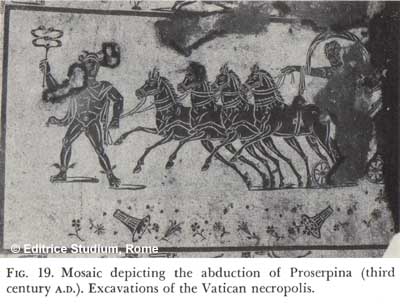 Corresponding
to this variety of ideas about life beyond the tomb there is a veriety
of religious currents which met and mingled at this time. This variety
is well demonstrated in the plaster ornaments in the tomb of the Valerii.
There, beside Minerva, the wise goddess of Olympus, can be seen Isis,
Apollo Harpocrates and Jupiter Dolichenus, three exotic divinities very
dear to the Romans of the imperial period; while satyrs and maenads proclaim,
with their frenzied dances, the invincible power of that Dionysus-Bacchus
whom the pagan society of the time considered a symbol of supreme happiness
in earthly life and also in the future world. It might even be said that
the religion of Dionysus predominates in this silent city of the dead.
The young Dionysus, with his gay cortege of satyrs and maenads, his panthers
and his thrysus and his festive, heavily-loaded bunches of grapes, seems
to promise, from the walls of tombs and from the carvings on marble saracophagi,
the end of troubles in an eternal happy drunkenness. (Fig. 20).
Corresponding
to this variety of ideas about life beyond the tomb there is a veriety
of religious currents which met and mingled at this time. This variety
is well demonstrated in the plaster ornaments in the tomb of the Valerii.
There, beside Minerva, the wise goddess of Olympus, can be seen Isis,
Apollo Harpocrates and Jupiter Dolichenus, three exotic divinities very
dear to the Romans of the imperial period; while satyrs and maenads proclaim,
with their frenzied dances, the invincible power of that Dionysus-Bacchus
whom the pagan society of the time considered a symbol of supreme happiness
in earthly life and also in the future world. It might even be said that
the religion of Dionysus predominates in this silent city of the dead.
The young Dionysus, with his gay cortege of satyrs and maenads, his panthers
and his thrysus and his festive, heavily-loaded bunches of grapes, seems
to promise, from the walls of tombs and from the carvings on marble saracophagi,
the end of troubles in an eternal happy drunkenness. (Fig. 20).
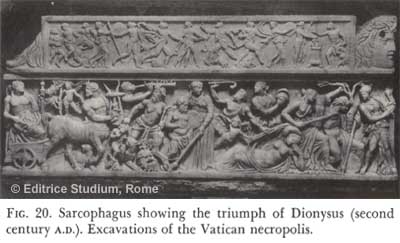 This
was, approximately, the spiritual milieu in which the elements of the
new Faith came to find their place. Side by side with the dead pagans
in this necropolis, Christians found their eternal rest. This promiscuity
sprang, undoubtedly, from the desire of the faithful to place their dead
in a cemetery which, as they firmly believed, held the sacred remains
of the Apostle Peter.
This
was, approximately, the spiritual milieu in which the elements of the
new Faith came to find their place. Side by side with the dead pagans
in this necropolis, Christians found their eternal rest. This promiscuity
sprang, undoubtedly, from the desire of the faithful to place their dead
in a cemetery which, as they firmly believed, held the sacred remains
of the Apostle Peter.
What are the Christian elements which, not including references to St. Peter, have been found so far in the Vatican necropolis?
A very
important Christian document is preserved for us in the tomb of the Valerii;
but, since it also concerns St. Peter, I propose to speak of it later.5
There are also some compartments found in the tomb of the Matuccii which
may be Christian, as, most probably, are the many resting places revealed
by the latest excavations under the pavement in the tomb of the Valerii.
There are also, here and there, funeral inscriptions which clearly refer
to the new Faith. Thus, a mutilated epigraph found in the so-called tomb
of the Egyptian (because of a resco representing the sparrow-headed Egyptian
god Horus) is shown to be Christian by the formula in pace followed by
a palm symbol. Similarly, in the tomb of the Cetennii, there are unquestionably
Christian inscriptions: the epigraph of a certain Siricius (a favorite
Christian name in the early centuries) and the moving epitaph of Aemilia
Gorgonia (Fig. 21) a woman, according to the inscription, of "remarkable
beauty and chastity." The stone is decorated with the customary motif
of doves and with the unusual figure of a woman taking water from a well.
The artist certainly wished this scene to represent the soul of the pious
dead woman receiving the symbolic water of eternal refreshment. Other
Christian epitaphs have been found in the tomb of the Valerii. The epitaph
carved on the sarcophagus of one Valerinus 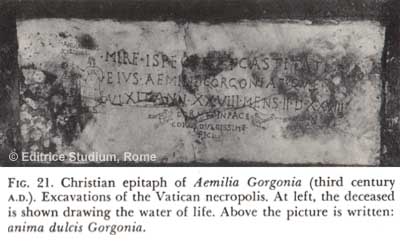
Vasatulus
must be considered Christian particularly because of the fact that it
mentions the date on which the deceased was placed in the tomb. Among
the Christians, the day of burial was considered worthy of being recorded
as a happy event, since it opened the gates of Paradise for the soul,
while among the pagans the custom was to avoid mentioning it since it
was considered a cause of everlasting sorrow. Another stone in the tomb
of the Valerii, shown to be Christian by the presence of the sign of the
Redeemer (![]() ),
records a man of good character who, as a true Christian, had passed his
life in perfect happiness: "he joked with everyone and never had quarrels."
),
records a man of good character who, as a true Christian, had passed his
life in perfect happiness: "he joked with everyone and never had quarrels."
But besides these stones which speak with suggestive frankness the language of the Faith, the necropolis has preserved for us an entirely Christian tomb which constitutes one of its greatest attractions. It is the tomb of the Julii, which was inserted between two older tombs, using their side walls. Belonging originally to pagans, as is indicated by the remains of some urns for ashes, it soon became a Christian tomb and was richly decorated with splendid mosaics. The transformation seems to have taken place in the first half of the third century. The brilliant mosaics which decorated the walls and the ceiling are now mostly fallen away, but the tesserae have left traces in the plaster, showing the design of the figures which have been lost. And the remaining section of the mosaic has a remarkable beauty and liveliness.
